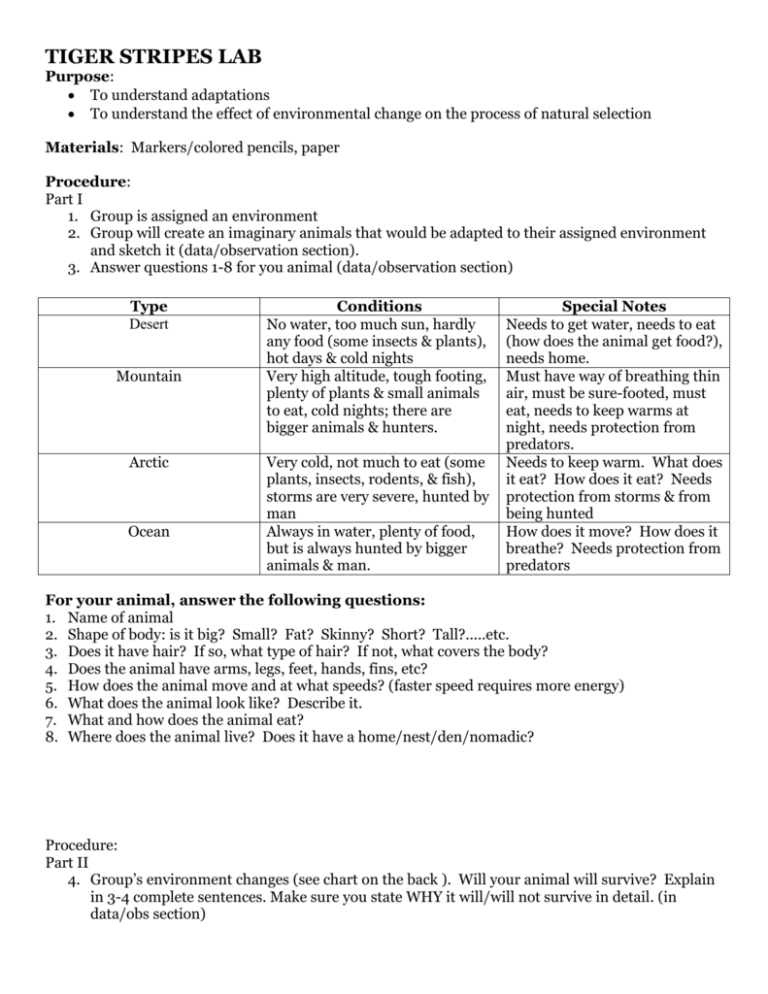Activity #1 Tiger Stripes
advertisement

TIGER STRIPES LAB Purpose: To understand adaptations To understand the effect of environmental change on the process of natural selection Materials: Markers/colored pencils, paper Procedure: Part I 1. Group is assigned an environment 2. Group will create an imaginary animals that would be adapted to their assigned environment and sketch it (data/observation section). 3. Answer questions 1-8 for you animal (data/observation section) Type Desert Mountain Arctic Ocean Conditions No water, too much sun, hardly any food (some insects & plants), hot days & cold nights Very high altitude, tough footing, plenty of plants & small animals to eat, cold nights; there are bigger animals & hunters. Very cold, not much to eat (some plants, insects, rodents, & fish), storms are very severe, hunted by man Always in water, plenty of food, but is always hunted by bigger animals & man. Special Notes Needs to get water, needs to eat (how does the animal get food?), needs home. Must have way of breathing thin air, must be sure-footed, must eat, needs to keep warms at night, needs protection from predators. Needs to keep warm. What does it eat? How does it eat? Needs protection from storms & from being hunted How does it move? How does it breathe? Needs protection from predators For your animal, answer the following questions: 1. Name of animal 2. Shape of body: is it big? Small? Fat? Skinny? Short? Tall?.....etc. 3. Does it have hair? If so, what type of hair? If not, what covers the body? 4. Does the animal have arms, legs, feet, hands, fins, etc? 5. How does the animal move and at what speeds? (faster speed requires more energy) 6. What does the animal look like? Describe it. 7. What and how does the animal eat? 8. Where does the animal live? Does it have a home/nest/den/nomadic? Procedure: Part II 4. Group’s environment changes (see chart on the back ). Will your animal will survive? Explain in 3-4 complete sentences. Make sure you state WHY it will/will not survive in detail. (in data/obs section) Environmental Changes: Type of Environment Changes Desert The desert got a lot hotter; a new animal moved into the desert & loves to eat your animal. Your animals need to keep cool & stay away from the predator. Can they? All of the sudden the main food source of your animal has died. It has also started to rain a lot more. Your animals need to live & stay dry. Can they? Your animal’s main source of food got sick of the cold weather & left. All of a sudden it got really dark in the winter. Now your animals needs a new food source. They need to see in the dark. Can they? More fisherpeople want to eat your animals. They need to go deeper in the ocean, but it is colder & darker down there. Your animals need to keep warm & see. Can they? Mountain Arctic Ocean Conclusion: For your conclusion, discuss evolution and natural selection. Can an animal change how they look to adapt to an environment? If the animal is not adapted, what happens? (At least 5-7 sentences). Use the following 3 prompts for your first three sentences 1. Can an animal change how they look to adapt to an environment? 2. If an animal is not adapted to a new environment, what happens to that animal? 3. Explain the term “natural selection.” This will be done in your lab journal or on notebook paper. It should look like this Title (5 pts): Purpose(5 pts): Materials(5 pts): Procedure(5 pts) Part I Data/Observations (30 points) Part I (sketch and questions 1-8 answered) Procedure(5 pts) Part II Data/Observations (20 points) Part II (explanation of whether your animal will live or not) Conclusion Paragraph (w/ necessary info included) (25 pts)






